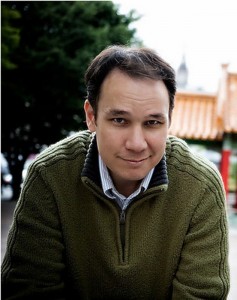What if I wrote an epic fantasy series that grounded readers first in the familiar, then took them to the stuff I’m doing that I feel is unique and new?
The journey to Trial of Intentions began in the year 2000. It started with a simple notion: What if I wrote an epic fantasy series that grounded readers first in the familiar, then took them to the stuff I’m doing that I feel is unique and new? That journey takes its next step on May 26th, when Trial of Intentions is released. But like any good story, there’s much more to it than that. And some of it is painful.
About the time I wrote the first book of the series, The Unremembered, I landed a literary agent. I won’t share his name. Suffice it to say he’s a noted agent in the field of science fiction and fantasy. He decided to represent me on the strength of a short story collection I’d had published by a small press. So, cool, right?
As we got to know one another, I shared with him my desire to write and publish books in horror, science fiction, thriller, and even (gasp) mainstream, in addition to fantasy. He nodded sagely to all this.
When I turned in the manuscript to book one of my epic fantasy series, he proceeded to tell me we should shelve it, and that I should focus on my thriller ideas, which he said he liked very much. I think my brow pinched in confusion. I’d just finished a book. He could go market it. Sell it. Make a commission. But I saluted and went off to write the thriller books that I was also eager to write. Read More »

In collaboration with editors John Joseph Adams and Hugh Howey, A Dribble of Ink is proud to introduce a series of interviews with the authors of The End Has Come, the final volume in the The Apocalypse Triptych. Following on The End is Nigh, and The End Is Here, The End Has Come contains 23 stories about life after the apocalypse.
Interview with Sarah Langan about “The Uncertainty Machine”
“Prototype” shows us a drastically changed world. How did this story evolve over the course of writing for a triptych?
I was really glad John contacted me, because I’d already written a couple hundred pages of a YA series (KIDS) set in the post apocalypse, but needed to more firmly build the mythology and rules of my strange world.
I got that opportunity– with The End Is Nigh I wrote “Love Perverts” which covers the basic themes of the YA series (parents selling out their childrens’ futures; survivors tending to be the least moral of a particular group), and also the nature of the apocalypse (asteroid). My story in The End is Here shows how the villains of my world came into existence (cyborgs!). And in The End Has Come, “Prototype” shows the world itself, and sets up the rules. Writing these stories has really crystalized things for me. I’m CRAZY excited to dig back into KIDS with this new perspective. Read More »

Via the New York Times, John Scalzi and Tor Books announced a new deal for thirteen novels worth a whopping $3.4 million. “Mr. Scalzi approached Tor Books, his longtime publisher, with proposals for 10 adult novels and three young adult novels over 10 years,” revealed John Schwartz of the New York Times.
Some of the included novels will be set in the same universe as Old Man’s War, and at least one will be a sequel to his most recent novel, Lock In. Scalzi’s editor at Tor, Patrick Nielsen Hayden, says that though Scalzi has never had a No. 1 bestseller, he “backlists like crazy.” Nielsen Hayden then revealed that Scalzi sells over 10,000 books a month, which is a very respectable number. “One of the reactions of people reading a John Scalzi novel is that people go out and buy all the other Scalzi novels,” Hayden said.
Scalzi’s Red Shirts, a satirical science fiction, won the Hugo Award for “Best Novel” in 2013.
“My celebration, personally, has just been standing around,” Scalzi told the New York Times. “And my wife saying, ‘Yes, now go take out the trash.’” It seems Scalzi’s trademark dry humour will remain intact, even under the weight of this mega deal.

In collaboration with editors John Joseph Adams and Hugh Howey, A Dribble of Ink is proud to introduce a series of interviews with the authors of The End Has Come, the final volume in the The Apocalypse Triptych. Following on The End is Nigh, and The End Is Here, The End Has Come contains 23 stories about life after the apocalypse.
Interview with Jamie Ford about “The Uncertainty Machine”
(Interview by Jude Griffin)
“The Uncertainty Machine” begins with a wonderful air of self-absorption and irony that carries through the entire tale with delicious intent. Often humor of this sort is not easy to maintain throughout a story. What sort of challenges did you encounter when setting Phineas’s story to paper?
It’s a fine line between full-on, David Koresh crazy, and a perma-tanned, toupee-wearing host on QVC. I mean––you never know how much of their own bullshit they actually believe. It’s this weird balance of vanity and madness. So it was interesting to try and put myself in that headspace where ego (for a while anyway) can supersede reality. Read More »

In collaboration with editors John Joseph Adams and Hugh Howey, A Dribble of Ink is proud to introduce a series of interviews with the authors of The End Has Come, the final volume in the The Apocalypse Triptych. Following on The End is Nigh, and The End Is Here, The End Has Come contains 23 stories about life after the apocalypse.
Interview with Robin Wasserman about “In the Valley of the Shadow of the Promised Land”
(Interview by Lee Hallison)
Abraham sacrifices Isaac in the bible – did you research biblical history before starting this triptych of stories?
No, I didn’t need to do much research–I went to Hebrew school all through my childhood, so these Bible stories are pretty much embedded in my subconscious. I actually didn’t set out to echo the Abraham/Isaac story in the first story–I only knew that I wanted to create something that would, eventually, form a religious origin story that would somehow be retold in the final story. (That story was originally titled “Midrash,” which is the Hebrew word for a collection of stories that, over the centuries, were extrapolated/intepreted from the text of the Old Testament. From the start, I imagined stories #1 and #2 as a kind of Midrash for the civilization of story #3.) It was only once I had the initial concept in place, and was honing in on the father-son relationship at the heart of it, that I realized I was working with a story that had already been told. Read More »





